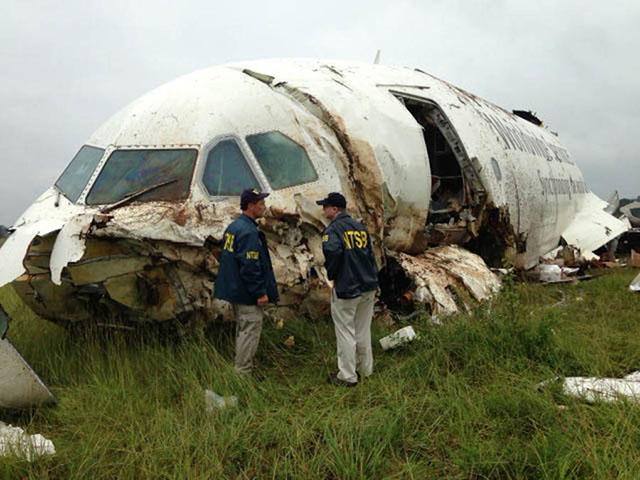This mishap shocked much of the 14 CFR 121 world in that highly qualified pilots flying a superbly equipped airplane managed to fly their airplane into the ground because of fatigue.
— James Albright

Updated:
2014-10-04
The pilots briefed and programmed their flight management systems to capture and fly a computer generated glide slope on a non-precision approach but failed to notice an FMS discontinuity that prevented the approach from sequencing properly. They ended up with no glideslope and the captain reverted to a "dive and drive" approach. Both pilots spotted the runway early but did not perceive their vertical velocity would end up far short of the runway.
How could such a highly qualified crew do this? As with many of these mishaps, the recommendations are more illuminating than the formally listed causes. Of note:
- Require principal operations inspectors to ensure that operators with flight crews performing 14 Code of Federal Regulations Part 121, 135, and 91 subpart K overnight operations brief the threat of fatigue before each departure, particularly those occurring during the window of circadian low.
and,
- Require principal operations inspectors of 14 Code of Federal Regulations Part 121, 135, and 91 subpart K operators to verify that procedures critical to approach setup, like configuring an approach in the flight management computer for those approaches dependent on that step, are included in Federal Aviation Administration-approved or -accepted manuals.
I would add another, which the NTSB did not comment on. Many aircraft cannot display FMS lateral information when flying a localizer based approach. On aircraft where the switch can be made automatically by the FMS, such as in the PlaneView series Gulfstreams, the FMS must properly sequence for this to happen. Pilots who routinely make the switch on their own can easily overlook that the FMS did not sequence onto the approach. While this usually only becomes important in the event of a missed approach, in this case it could have saved the day by alerting them to the fact their FMS generated glide slope was not available. I believe crews should allow at least the copilot's FMS to perform the switch to raw data as a crosscheck that proper sequencing did occur. (Of course in the PlaneView aircraft you could not have gotten the FMS vertical path with the localizer raw data so the missing vertical path issue isn't applicable, but the problem of a failure to sequence certainly is.)

1
Accident report
- Date: 14 Aug 2013
- Time: 0447
- Type: Airbus A300F4-622R
- Operator: United Parcel Service (UPS)
- Registration: N155UP
- Fatalities: 2 of 2 crew
- Aircraft Fate: Destroyed
- Phase: Approach
- Departure Airport: Louisville International Airport, KY (KSDF)
- Destination Airport: Birmingham-Shuttlesworth International Airport, AL (KBHM)
2
Narrative
- On August 14, 2013, about 0447 central daylight time (CDT), United Parcel Service (UPS) flight 1354, an Airbus A300-600, N155UP, crashed short of runway 18 during a localizer non-precision approach to runway 18 at Birmingham-Shuttlesworth International Airport (BHM), Birmingham, Alabama. The captain and first officer were fatally injured, and the airplane was destroyed by impact forces and postcrash fire. The scheduled cargo flight was operating under the provisions of 14 Code of Federal Regulations Part 121 on an instrument flight rules flight plan, and dark night visual flight rules conditions prevailed at the airport; variable instrument meteorological conditions (IMC) with a variable ceiling were present north of the airport on the approach course at the time of the accident.
- The captain was the pilot flying, and the first officer was the pilot monitoring. Before descent, while on the direct-to-KBHM leg of the flight, the captain briefed the localizer runway 18 non-precision profile approach, and the first officer entered the approach into the airplane's flight management computer (FMC). The intended method of descent (a "profile approach") used a generated by the FMC to provide vertical path guidance to the crew during the descent from the final approach fix (FAF) to the decision altitude, as opposed to the step-down method ("dive and drive") that did not provide vertical guidance and required the crew to refer to the altimeter to ensure that the airplane remained above the minimum crossing altitude at each of the approach fixes. When flown as a profile approach, the localizer approach to runway 18 had a decision altitude of 1,200 ft mean sea level (msl), which required the pilots to decide at that point to continue descending to the runway if the runway was in sight or execute a missed approach.
Source: NTSB Synopsis
This is a "best practice" and certainly the smart thing to do.
See: Continuous Descent Final Approach.
- As the airplane neared the FAF, the air traffic controller cleared the flight for the localizer 18 approach. However, although the flight plan for the approach had already been entered in the FMC, the captain did not request and the first officer did not verify that the flight plan reflected only the approach fixes; therefore, the direct-to-KBHM leg that had been set up during the flight from Louisville remained in the FMC. This caused a flight plan discontinuity message to remain in the FMC, which rendered the glideslope generated for the profile approach meaningless. The controller then cleared the pilots to land on runway 18, and the first officer performed the Before Landing checklist. The airplane approached the FAF at an altitude of 2,500 ft msl, which was 200 ft higher than the published minimum crossing altitude of 2,300 ft.
Source: NTSB Synopsis
Some crews routinely switch from FMS approach data to raw data when cleared for a localizer-based approach. This could rob them on valuable back up information. If, in this case, the first officer had left her approach instruments on FMS data, she might have noticed the failure of the approach to sequence. (Note: this may or may not apply to the Airbus 300 and is offered only as a technique for those aircraft where the switch from FMS to raw data can be made automatically.)
- About 7 seconds after the first officer completed the Before Landing checklist, the first officer noted that the captain had switched the autopilot to vertical speed mode; shortly thereafter, the captain increased the vertical descent rate to 1,500 feet per minute (fpm). The first officer made the required 1,000-ft above-airport-elevation callout, and the captain noted that the decision altitude was 1,200 ft msl but maintained the 1,500 fpm descent rate. Once the airplane descended below 1,000 ft at a descent rate greater than 1,000 fpm, the approach would have violated the stabilized approach criteria defined in the UPS flight operations manual and would have required a go-around. As the airplane descended to the minimum descent altitude, the first officer did not make the required callouts regarding approaching and reaching the minimum descent altitude, and the captain did not arrest the descent at the minimum descent altitude.
- The airplane continued to descend, and at 1,000 ft msl (about 250 ft above ground level), an enhanced ground proximity warning system (EGPWS) "sink rate" caution alert was triggered. The captain began to adjust the vertical speed in accordance with UPS's trained procedure, and he reported the runway in sight about 3.5 seconds after the "sink rate" caution alert. The airplane continued to descend at a rate of about 1,000 fpm. The first officer then confirmed that she also had the runway in sight. About 2 seconds after reporting the runway in sight, the captain further reduced the commanded vertical speed, but the airplane was still descending rapidly on a trajectory that was about 1 nautical mile short of the runway. Neither pilot appeared to be aware of the airplane's altitude after the first officer's 1,000-ft callout. The cockpit voice recorder then recorded the sound of the airplane contacting trees followed by an EGPWS "too low terrain" caution alert.
Source: NTSB Synopsis
3
Analysis
- Had the FMC been properly sequenced and the profile approach selected, the autopilot would have engaged the profile approach and the airplane would have begun a descent on the to the runway. However, this did not occur. Neither pilot recognized the flight plan was not verified. Further, because of the meaningless FMC , the vertical deviation indicator (VDI), which is the primary source of vertical path correction information, would have been pegged at the top of its scale (a full-scale deflection), indicating the airplane was more than 200 ft below the (meaningless) . However, neither pilot recognized the meaningless information even though they knew they were above, not below, the glideslope at the FAF. When the autopilot did not engage in profile mode, the captain changed the autopilot mode to the vertical speed mode, yet he did not brief the first officer of the autopilot mode change. Further, by selecting the vertical speed mode, the approach essentially became a "dive and drive" approach. In a profile approach, a go-around is required upon arrival at the decision altitude (1,200 ft) if the runway is not in sight; in a "dive-and-drive" approach, the pilot descends the airplane to the minimum descent altitude (also 1,200 ft in the case of the localizer approach to runway 18 at BHM) and levels off. Descent below the minimum descent altitude is not permitted until the runway is in sight and the aircraft can make a normal descent to the runway. A go-around is not required for a "dive and drive" approach until the airplane reaches the missed approach point at the minimum descent altitude and the runway is not in sight. Because the airplane was descending in vertical speed mode without valid vertical path guidance from the VDI, it became even more critical for the flight crew to monitor their altitude and level off at the minimum descent altitude.
Source: NTSB Synopsis
We often assume our actions from the left seat are observed and understood by the pilot in the right seat. But that pilot is often busy with other chores, especially during the busy approach and landing phase. For these times, at the very least, all autopilot and flight director programming actions should be verbally called out.
More about this: callouts.
4
Cause
The National Transportation Safety Board determines that the probable cause of this accident was the flight crew's continuation of an unstabilized approach and their failure to monitor the aircraft's altitude during the approach, which led to an inadvertent descent below the minimum approach altitude and subsequently into terrain. Contributing to the accident were:
- the flight crew's failure to properly configure and verify the flight management computer for the profile approach;
- the captain's failure to communicate his intentions to the first officer once it became apparent the vertical profile was not captured;
- the flight crew's expectation that they would break out of the clouds at 1,000 feet above ground level due to incomplete weather information;
- the first officer's failure to make the required minimums callouts;
- the captain's performance deficiencies likely due to factors including, but not limited to, fatigue, distraction, or confusion, consistent with performance deficiencies exhibited during training; and
- the first officer's fatigue due to acute sleep loss resulting from her ineffective off-duty time management and circadian factors.
Source: NTSB Synopsis
References
(Source material)
Preliminary Report Aviation, National Transportation Safety Board ID: DCA13MA133, 8/29/2013
